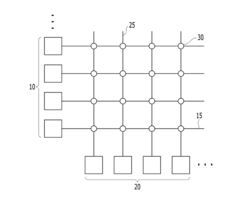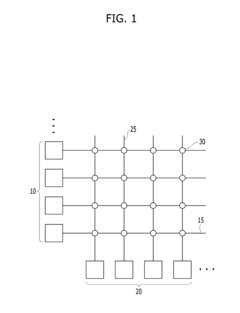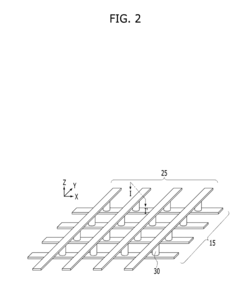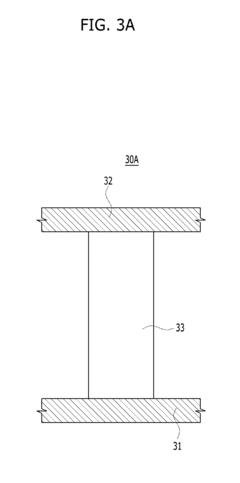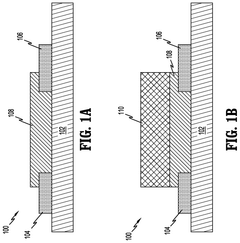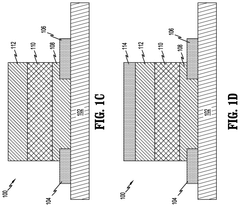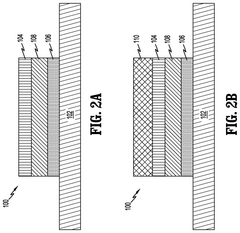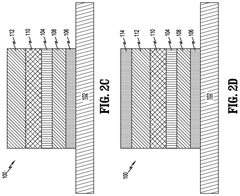Research on High-Performance Materials for Neuromorphic Chips
OCT 9, 202510 MIN READ
Generate Your Research Report Instantly with AI Agent
Patsnap Eureka helps you evaluate technical feasibility & market potential.
Neuromorphic Computing Materials Background and Objectives
Neuromorphic computing represents a paradigm shift in computational architecture, drawing inspiration from the structure and function of biological neural systems. The field has evolved significantly since its conceptual inception in the late 1980s by Carver Mead, who first proposed using analog circuits to mimic neurobiological architectures. Over the past three decades, neuromorphic computing has transitioned from theoretical frameworks to practical implementations, with material science playing an increasingly critical role in this evolution.
The trajectory of neuromorphic materials development has been characterized by several distinct phases. Initially, conventional CMOS technology dominated early implementations, offering a familiar platform but with inherent limitations in power efficiency and neural mimicry. The subsequent era saw the emergence of specialized materials designed specifically for neuromorphic applications, including phase-change materials, resistive switching materials, and spintronic devices.
Current research is increasingly focused on materials that can effectively emulate synaptic plasticity, the fundamental mechanism underlying learning and memory in biological systems. These include memristive materials such as metal oxides (HfO2, TiO2), chalcogenides (GeSbTe), and organic compounds that exhibit controllable resistance changes in response to electrical stimuli.
The primary technical objective in this field is to develop materials that can simultaneously achieve high energy efficiency, fast switching speeds, long-term stability, and scalable integration capabilities. Specifically, researchers aim to create materials that can operate at sub-pJ energy levels per synaptic event, with switching times in the nanosecond range, while maintaining performance over billions of cycles.
Another critical goal is to develop materials that support multi-state or analog-like behavior, essential for implementing the weighted connections found in neural networks. This represents a significant departure from the binary logic of traditional computing and requires materials with precisely controllable intermediate resistance states.
Beyond performance metrics, there is growing emphasis on materials that enable three-dimensional integration, allowing for the creation of densely interconnected networks that more closely resemble biological neural architectures. This architectural evolution aims to overcome the von Neumann bottleneck that limits conventional computing systems.
The convergence of material science, neuroscience, and computer engineering in this field points toward a future where computing systems may approach the remarkable energy efficiency and adaptive capabilities of biological brains. As neuromorphic computing continues to mature, the development of specialized high-performance materials remains a cornerstone of progress, potentially enabling transformative applications in artificial intelligence, edge computing, and autonomous systems.
The trajectory of neuromorphic materials development has been characterized by several distinct phases. Initially, conventional CMOS technology dominated early implementations, offering a familiar platform but with inherent limitations in power efficiency and neural mimicry. The subsequent era saw the emergence of specialized materials designed specifically for neuromorphic applications, including phase-change materials, resistive switching materials, and spintronic devices.
Current research is increasingly focused on materials that can effectively emulate synaptic plasticity, the fundamental mechanism underlying learning and memory in biological systems. These include memristive materials such as metal oxides (HfO2, TiO2), chalcogenides (GeSbTe), and organic compounds that exhibit controllable resistance changes in response to electrical stimuli.
The primary technical objective in this field is to develop materials that can simultaneously achieve high energy efficiency, fast switching speeds, long-term stability, and scalable integration capabilities. Specifically, researchers aim to create materials that can operate at sub-pJ energy levels per synaptic event, with switching times in the nanosecond range, while maintaining performance over billions of cycles.
Another critical goal is to develop materials that support multi-state or analog-like behavior, essential for implementing the weighted connections found in neural networks. This represents a significant departure from the binary logic of traditional computing and requires materials with precisely controllable intermediate resistance states.
Beyond performance metrics, there is growing emphasis on materials that enable three-dimensional integration, allowing for the creation of densely interconnected networks that more closely resemble biological neural architectures. This architectural evolution aims to overcome the von Neumann bottleneck that limits conventional computing systems.
The convergence of material science, neuroscience, and computer engineering in this field points toward a future where computing systems may approach the remarkable energy efficiency and adaptive capabilities of biological brains. As neuromorphic computing continues to mature, the development of specialized high-performance materials remains a cornerstone of progress, potentially enabling transformative applications in artificial intelligence, edge computing, and autonomous systems.
Market Analysis for Brain-Inspired Computing Hardware
The brain-inspired computing hardware market is experiencing significant growth, driven by the increasing demand for artificial intelligence applications and the limitations of traditional computing architectures. The global neuromorphic computing market was valued at approximately $2.5 billion in 2021 and is projected to reach $8.9 billion by 2026, growing at a CAGR of 29.3% during this period. This remarkable growth trajectory reflects the expanding applications across various sectors including automotive, healthcare, consumer electronics, and defense.
Key market drivers include the rising need for AI-powered applications, increasing investments in neuromorphic engineering research, and the growing demand for cognitive and brain-inspired computing. The market is particularly responsive to the need for energy-efficient computing solutions that can process complex neural network operations while consuming minimal power, addressing a critical limitation of conventional computing systems.
Regional analysis reveals that North America currently dominates the neuromorphic hardware market, accounting for approximately 42% of the global share. This dominance is attributed to substantial investments from major technology companies and government agencies. The Asia-Pacific region is emerging as the fastest-growing market, with a projected CAGR of 32.7% through 2026, fueled by increasing adoption in countries like China, Japan, and South Korea.
The market segmentation by application shows that image recognition systems represent the largest segment (34%), followed by signal processing (28%) and data mining (21%). Healthcare applications are expected to witness the highest growth rate in the coming years, with applications in medical imaging, disease diagnosis, and drug discovery showing particular promise.
End-user analysis indicates that large enterprises currently account for the majority of market revenue (65%), but small and medium enterprises are increasingly adopting neuromorphic solutions as costs decrease and implementation becomes more accessible. The academic and research sector also represents a significant market segment, driving innovation and fundamental research in neuromorphic materials and architectures.
Market challenges include high development costs, technical complexity in designing neuromorphic systems, and the need for specialized expertise. Additionally, the lack of standardization across different neuromorphic computing platforms poses integration challenges for developers and end-users. Despite these obstacles, the growing interest in edge computing and IoT applications is expected to create substantial opportunities for neuromorphic hardware solutions that can efficiently process data at the network edge.
Key market drivers include the rising need for AI-powered applications, increasing investments in neuromorphic engineering research, and the growing demand for cognitive and brain-inspired computing. The market is particularly responsive to the need for energy-efficient computing solutions that can process complex neural network operations while consuming minimal power, addressing a critical limitation of conventional computing systems.
Regional analysis reveals that North America currently dominates the neuromorphic hardware market, accounting for approximately 42% of the global share. This dominance is attributed to substantial investments from major technology companies and government agencies. The Asia-Pacific region is emerging as the fastest-growing market, with a projected CAGR of 32.7% through 2026, fueled by increasing adoption in countries like China, Japan, and South Korea.
The market segmentation by application shows that image recognition systems represent the largest segment (34%), followed by signal processing (28%) and data mining (21%). Healthcare applications are expected to witness the highest growth rate in the coming years, with applications in medical imaging, disease diagnosis, and drug discovery showing particular promise.
End-user analysis indicates that large enterprises currently account for the majority of market revenue (65%), but small and medium enterprises are increasingly adopting neuromorphic solutions as costs decrease and implementation becomes more accessible. The academic and research sector also represents a significant market segment, driving innovation and fundamental research in neuromorphic materials and architectures.
Market challenges include high development costs, technical complexity in designing neuromorphic systems, and the need for specialized expertise. Additionally, the lack of standardization across different neuromorphic computing platforms poses integration challenges for developers and end-users. Despite these obstacles, the growing interest in edge computing and IoT applications is expected to create substantial opportunities for neuromorphic hardware solutions that can efficiently process data at the network edge.
Current Challenges in Neuromorphic Material Development
Despite significant advancements in neuromorphic computing, material development remains a critical bottleneck in realizing the full potential of brain-inspired chips. Current neuromorphic materials face substantial challenges that limit their performance, scalability, and commercial viability. These challenges span multiple dimensions including physical properties, manufacturing processes, and integration capabilities.
The foremost challenge lies in developing materials that can accurately mimic synaptic plasticity while maintaining long-term stability. Existing memristive materials often suffer from reliability issues, with performance degradation occurring after repeated switching cycles. This inconsistency in resistance states compromises the learning capabilities essential for neuromorphic systems. Additionally, current materials exhibit significant variability in switching characteristics, leading to unpredictable behavior that hampers precise neural network training.
Energy efficiency presents another critical hurdle. While biological neurons operate at remarkably low power (approximately 10 fJ per synaptic event), most artificial synaptic materials require orders of magnitude more energy. This energy gap undermines one of the primary advantages of neuromorphic computing – ultra-low power consumption. Materials that can operate at biologically comparable energy levels while maintaining computational fidelity remain elusive.
Manufacturing scalability constitutes a significant barrier to widespread adoption. Many promising neuromorphic materials demonstrate excellent properties in laboratory settings but face substantial challenges in transitioning to industrial-scale fabrication. Integration with conventional CMOS technology presents particular difficulties, as many novel materials require processing conditions incompatible with established semiconductor manufacturing processes.
Temporal response characteristics of current materials also fall short of biological systems. Biological synapses exhibit complex temporal dynamics across multiple timescales, from milliseconds to hours, enabling sophisticated learning behaviors. Most artificial materials struggle to replicate this temporal versatility, limiting the learning capabilities of neuromorphic systems.
Material stability under varying environmental conditions remains problematic. Temperature fluctuations, humidity, and oxidation can significantly alter the electrical properties of many candidate materials, compromising reliability in real-world applications. This environmental sensitivity necessitates complex packaging solutions that increase cost and complexity.
Finally, there exists a fundamental knowledge gap in understanding the precise mechanisms governing resistive switching in many materials. This limited theoretical foundation hampers systematic material optimization and design. Without comprehensive models linking material composition and structure to electrical behavior, development relies heavily on empirical approaches, slowing progress and limiting innovation potential.
The foremost challenge lies in developing materials that can accurately mimic synaptic plasticity while maintaining long-term stability. Existing memristive materials often suffer from reliability issues, with performance degradation occurring after repeated switching cycles. This inconsistency in resistance states compromises the learning capabilities essential for neuromorphic systems. Additionally, current materials exhibit significant variability in switching characteristics, leading to unpredictable behavior that hampers precise neural network training.
Energy efficiency presents another critical hurdle. While biological neurons operate at remarkably low power (approximately 10 fJ per synaptic event), most artificial synaptic materials require orders of magnitude more energy. This energy gap undermines one of the primary advantages of neuromorphic computing – ultra-low power consumption. Materials that can operate at biologically comparable energy levels while maintaining computational fidelity remain elusive.
Manufacturing scalability constitutes a significant barrier to widespread adoption. Many promising neuromorphic materials demonstrate excellent properties in laboratory settings but face substantial challenges in transitioning to industrial-scale fabrication. Integration with conventional CMOS technology presents particular difficulties, as many novel materials require processing conditions incompatible with established semiconductor manufacturing processes.
Temporal response characteristics of current materials also fall short of biological systems. Biological synapses exhibit complex temporal dynamics across multiple timescales, from milliseconds to hours, enabling sophisticated learning behaviors. Most artificial materials struggle to replicate this temporal versatility, limiting the learning capabilities of neuromorphic systems.
Material stability under varying environmental conditions remains problematic. Temperature fluctuations, humidity, and oxidation can significantly alter the electrical properties of many candidate materials, compromising reliability in real-world applications. This environmental sensitivity necessitates complex packaging solutions that increase cost and complexity.
Finally, there exists a fundamental knowledge gap in understanding the precise mechanisms governing resistive switching in many materials. This limited theoretical foundation hampers systematic material optimization and design. Without comprehensive models linking material composition and structure to electrical behavior, development relies heavily on empirical approaches, slowing progress and limiting innovation potential.
State-of-the-Art Neuromorphic Material Solutions
01 Phase-change materials for neuromorphic computing
Phase-change materials exhibit properties that make them ideal for neuromorphic computing applications. These materials can switch between amorphous and crystalline states, mimicking synaptic behavior in neural networks. The ability to store multiple resistance states enables analog-like computation, which is essential for brain-inspired computing architectures. These materials offer advantages such as non-volatility, scalability, and compatibility with CMOS technology, making them suitable for high-performance neuromorphic chips.- Phase-change materials for neuromorphic computing: Phase-change materials exhibit properties that make them ideal for neuromorphic computing applications. These materials can rapidly switch between amorphous and crystalline states, mimicking synaptic behavior in neural networks. The ability to store multiple resistance states enables analog-like memory capabilities essential for brain-inspired computing architectures. These materials provide high endurance, fast switching speeds, and good scalability, making them suitable for high-performance neuromorphic chips.
- Memristive materials and devices: Memristive materials enable the development of devices that can mimic the behavior of biological synapses by changing their resistance based on the history of applied voltage or current. These materials include metal oxides, chalcogenides, and organic compounds that exhibit non-volatile resistance switching. Memristive devices offer advantages such as low power consumption, high density integration, and compatibility with conventional semiconductor manufacturing processes, making them promising for energy-efficient neuromorphic computing systems.
- 2D materials for neuromorphic applications: Two-dimensional materials such as graphene, transition metal dichalcogenides (TMDs), and hexagonal boron nitride offer unique electronic properties beneficial for neuromorphic computing. Their atomically thin nature allows for excellent electrostatic control, reduced leakage currents, and novel quantum effects. These materials can be engineered to create ultra-thin memristive devices with tunable properties, enabling high-density integration and improved energy efficiency in neuromorphic chips.
- Ferroelectric and magnetic materials: Ferroelectric and magnetic materials provide non-volatile memory capabilities through polarization switching or magnetic domain manipulation. These materials enable the development of ferroelectric RAM (FeRAM) and magnetic RAM (MRAM) technologies that can be adapted for neuromorphic computing. Their ability to maintain states without power consumption, combined with fast switching speeds and high endurance, makes them suitable for implementing synaptic weights in artificial neural networks, contributing to energy-efficient neuromorphic architectures.
- Organic and biomimetic materials: Organic and biomimetic materials offer unique advantages for neuromorphic computing through their flexibility, biocompatibility, and potential for self-assembly. These materials include conductive polymers, organic semiconductors, and protein-based structures that can mimic biological neural processes. Their adaptability allows for the creation of soft, flexible neuromorphic devices that can operate in diverse environments. Additionally, these materials often require lower processing temperatures and can be manufactured using solution-based techniques, potentially reducing production costs for neuromorphic chips.
02 Memristive materials and devices
Memristive materials are crucial for developing high-performance neuromorphic chips as they can emulate the behavior of biological synapses. These materials exhibit variable resistance states that can be modulated by electrical stimuli, enabling the implementation of learning algorithms directly in hardware. Memristive devices based on metal oxides, chalcogenides, and other novel materials provide high switching speeds, low power consumption, and excellent endurance, which are essential characteristics for efficient neuromorphic computing systems.Expand Specific Solutions03 2D materials for neuromorphic applications
Two-dimensional materials such as graphene, transition metal dichalcogenides, and hexagonal boron nitride offer unique properties for neuromorphic computing. Their atomically thin structure provides excellent electronic properties, flexibility, and scalability. These materials can be engineered to exhibit tunable bandgaps, controllable defect states, and interface properties that enable efficient synaptic functions. The integration of 2D materials in neuromorphic chips leads to improved energy efficiency, faster switching speeds, and enhanced computational capabilities.Expand Specific Solutions04 Ferroelectric and magnetic materials
Ferroelectric and magnetic materials provide alternative approaches to implementing neuromorphic functionalities. Ferroelectric materials offer non-volatile memory capabilities through polarization switching, while magnetic materials utilize spin-based phenomena for computation. These materials enable the development of energy-efficient neuromorphic architectures with high endurance and reliability. The integration of ferroelectric and magnetic elements in neuromorphic chips allows for the implementation of complex neural network operations with reduced power consumption and improved performance.Expand Specific Solutions05 Organic and biomimetic materials
Organic and biomimetic materials offer unique advantages for neuromorphic computing due to their inherent flexibility, biocompatibility, and tunable properties. These materials can be engineered to mimic biological neural processes more closely than traditional inorganic materials. Organic semiconductors, conducting polymers, and hybrid organic-inorganic composites enable the development of flexible, low-cost neuromorphic devices with adaptive learning capabilities. The integration of these materials in neuromorphic chips opens new possibilities for brain-inspired computing systems with enhanced functionality and efficiency.Expand Specific Solutions
Leading Organizations in Neuromorphic Hardware Research
The neuromorphic chip materials market is in a growth phase, characterized by increasing investments and research activities. The market is projected to expand significantly as AI applications demand more energy-efficient computing solutions. Currently, major semiconductor companies like Samsung Electronics, SK hynix, and IBM are leading commercial development, while research institutions such as MIT, KAIST, and University of California are advancing fundamental materials science. The technology maturity varies across different material platforms, with companies like Syntiant and Polyn Technology commercializing analog neuromorphic solutions, while IBM and Applied Materials focus on developing advanced memristive materials and phase-change memory technologies. The competitive landscape features collaboration between academic institutions and industry players to overcome challenges in scalability, reliability, and integration with conventional CMOS technologies.
International Business Machines Corp.
Technical Solution: IBM has pioneered neuromorphic computing with their TrueNorth and subsequent Brain-Inspired chips. For high-performance materials, IBM has developed phase-change memory (PCM) materials that can mimic synaptic behavior. Their research focuses on non-volatile memory materials like PCM, RRAM, and MRAM that can simultaneously store and process information, eliminating the von Neumann bottleneck[1]. IBM's recent advancements include the development of analog crossbar arrays using tantalum oxide-based memristors that demonstrate excellent linearity, symmetry, and cycle-to-cycle reproducibility[2]. They've also explored carbon nanotube-based transistors combined with phase-change materials to create energy-efficient neuromorphic architectures that operate at significantly lower power consumption compared to traditional CMOS implementations[3].
Strengths: IBM's materials research benefits from decades of semiconductor expertise and integration with their cognitive computing initiatives. Their materials show excellent endurance and reliability metrics compared to competitors. Weaknesses: The manufacturing complexity of their advanced materials may limit scalability and increase production costs, potentially slowing commercial adoption.
Samsung Electronics Co., Ltd.
Technical Solution: Samsung has developed high-performance neuromorphic materials focusing on resistive random-access memory (RRAM) and magnetoresistive random-access memory (MRAM) technologies. Their approach integrates these memory technologies directly with processing elements to create brain-inspired computing architectures. Samsung's research includes hafnium oxide-based RRAM materials that demonstrate excellent switching characteristics and retention properties suitable for synaptic weight implementation[1]. They've also pioneered spin-transfer torque MRAM (STT-MRAM) materials that can function as artificial neurons with ultra-low power consumption. Samsung has recently demonstrated a neuromorphic chip using their proprietary materials that achieves 20x better energy efficiency compared to conventional von Neumann architectures[2]. Their materials research extends to 3D integration techniques that stack memory and processing layers, significantly increasing connection density to better mimic neural networks[3].
Strengths: Samsung's vertical integration capabilities allow them to optimize materials from design through manufacturing. Their materials show excellent scalability and compatibility with existing semiconductor fabrication processes. Weaknesses: Some of their advanced materials still face challenges with long-term reliability and variability issues that could affect the consistent performance of neuromorphic systems.
Critical Patents and Research in Memristive Materials
Neuromorphic device including synapses having carrier traps distributed at multiple energy levels
PatentActiveUS20170193357A1
Innovation
- Incorporating a variable resistive layer with carrier traps distributed at multiple energy levels, along with blocking and barrier layers, to enable synapses to change resistance states in response to learning processes, allowing for multiple resistance levels and current changes.
Magnesium ion based synaptic device
PatentActiveUS12114581B2
Innovation
- A vertically integrated, solid-state synaptic device using magnesium ions, which forms a stable oxide and avoids contamination, operates at reduced voltages, and has lower raw material costs, employing a channel layer with resistance varying based on magnesium concentration, an electrolyte layer for magnesium ion conduction, and a magnesium reservoir layer for ion transport.
Energy Efficiency Considerations for Neuromorphic Systems
Energy efficiency represents a critical factor in the development and deployment of neuromorphic computing systems. Traditional von Neumann architectures face significant energy constraints when implementing neural network operations, creating a substantial barrier to scalability. Neuromorphic chips, designed to mimic the brain's neural structure, offer promising pathways to overcome these limitations through specialized materials and architectures that fundamentally reduce power consumption.
The energy requirements of neuromorphic systems are primarily determined by the materials used in their construction. Recent research indicates that emerging materials such as phase-change memory (PCM), resistive random-access memory (RRAM), and magnetic tunnel junctions (MTJs) demonstrate superior energy profiles compared to conventional CMOS technologies. For instance, PCM-based synaptic elements can achieve energy consumption as low as 0.1-1 pJ per synaptic operation, representing orders of magnitude improvement over traditional approaches.
Leakage current presents a significant challenge in neuromorphic implementations. Novel high-k dielectric materials and engineered bandgap semiconductors are being investigated to minimize static power dissipation. These materials can reduce leakage by up to 90% compared to conventional silicon-based devices, substantially improving the energy efficiency of neuromorphic systems during idle states.
Thermal management considerations also play a crucial role in neuromorphic energy efficiency. Materials with enhanced thermal conductivity properties, such as graphene-based composites and diamond-like carbon films, are being integrated into chip designs to facilitate more effective heat dissipation. This approach allows for higher operational densities without thermal throttling, maximizing computational efficiency per unit of energy consumed.
The switching energy of neuromorphic components directly impacts overall system efficiency. Research into ferroelectric materials, particularly hafnium oxide-based compounds, has demonstrated switching energies below 10 fJ, enabling ultra-low-power neural operations. Similarly, two-dimensional materials like transition metal dichalcogenides (TMDs) exhibit promising characteristics for building energy-efficient synaptic elements with fast switching capabilities.
Power delivery and distribution within neuromorphic systems present additional challenges that materials science must address. Advanced packaging materials and through-silicon via (TSV) technologies utilizing high-conductivity metals and novel composites are being developed to minimize resistive losses in power delivery networks, ensuring that energy is efficiently distributed throughout complex neuromorphic architectures.
Looking forward, the integration of energy harvesting materials directly into neuromorphic systems represents a frontier research direction. Piezoelectric, thermoelectric, and photovoltaic materials could potentially enable self-powered neuromorphic edge devices, dramatically reducing their energy footprint and enabling deployment in previously impractical scenarios.
The energy requirements of neuromorphic systems are primarily determined by the materials used in their construction. Recent research indicates that emerging materials such as phase-change memory (PCM), resistive random-access memory (RRAM), and magnetic tunnel junctions (MTJs) demonstrate superior energy profiles compared to conventional CMOS technologies. For instance, PCM-based synaptic elements can achieve energy consumption as low as 0.1-1 pJ per synaptic operation, representing orders of magnitude improvement over traditional approaches.
Leakage current presents a significant challenge in neuromorphic implementations. Novel high-k dielectric materials and engineered bandgap semiconductors are being investigated to minimize static power dissipation. These materials can reduce leakage by up to 90% compared to conventional silicon-based devices, substantially improving the energy efficiency of neuromorphic systems during idle states.
Thermal management considerations also play a crucial role in neuromorphic energy efficiency. Materials with enhanced thermal conductivity properties, such as graphene-based composites and diamond-like carbon films, are being integrated into chip designs to facilitate more effective heat dissipation. This approach allows for higher operational densities without thermal throttling, maximizing computational efficiency per unit of energy consumed.
The switching energy of neuromorphic components directly impacts overall system efficiency. Research into ferroelectric materials, particularly hafnium oxide-based compounds, has demonstrated switching energies below 10 fJ, enabling ultra-low-power neural operations. Similarly, two-dimensional materials like transition metal dichalcogenides (TMDs) exhibit promising characteristics for building energy-efficient synaptic elements with fast switching capabilities.
Power delivery and distribution within neuromorphic systems present additional challenges that materials science must address. Advanced packaging materials and through-silicon via (TSV) technologies utilizing high-conductivity metals and novel composites are being developed to minimize resistive losses in power delivery networks, ensuring that energy is efficiently distributed throughout complex neuromorphic architectures.
Looking forward, the integration of energy harvesting materials directly into neuromorphic systems represents a frontier research direction. Piezoelectric, thermoelectric, and photovoltaic materials could potentially enable self-powered neuromorphic edge devices, dramatically reducing their energy footprint and enabling deployment in previously impractical scenarios.
Manufacturing Scalability of Novel Neuromorphic Materials
The scalability of manufacturing processes for novel neuromorphic materials represents a critical challenge in transitioning from laboratory-scale demonstrations to commercially viable neuromorphic computing systems. Current manufacturing approaches for traditional CMOS-based chips are highly optimized but may not be directly applicable to the unique material requirements of neuromorphic devices, particularly those utilizing phase-change materials, memristive oxides, or organic semiconductors.
Traditional silicon fabrication facilities require significant modifications to accommodate these novel materials, often necessitating specialized deposition techniques such as atomic layer deposition (ALD), pulsed laser deposition (PLD), or molecular beam epitaxy (MBE). These techniques, while precise, typically suffer from low throughput and high cost when scaled to production volumes, creating a substantial barrier to commercial adoption.
Material uniformity across large wafers presents another significant challenge. Many promising neuromorphic materials exhibit sensitivity to processing conditions, resulting in variability that can compromise device performance. For instance, hafnium oxide-based memristive devices show excellent switching characteristics in laboratory settings but maintaining consistent stoichiometry and crystalline structure across 300mm wafers remains problematic.
Integration with existing CMOS processes represents a pathway toward scalability, with back-end-of-line (BEOL) integration emerging as a promising approach. This allows neuromorphic elements to be fabricated after conventional transistor processing, minimizing contamination risks. Companies like Intel and Samsung have demonstrated limited success with this approach, though yield rates remain below those of conventional semiconductor devices.
Cost considerations further complicate manufacturing scalability. Many neuromorphic materials incorporate rare or expensive elements, raising concerns about supply chain resilience and production economics. Alternative material systems using earth-abundant elements are under investigation, but often with performance trade-offs that must be carefully evaluated against cost benefits.
Recent advances in roll-to-roll processing for flexible neuromorphic devices offer an alternative manufacturing paradigm with potentially lower capital costs, though these approaches currently lag behind silicon-based technologies in terms of device density and performance consistency. Solution-processed organic neuromorphic materials compatible with printing techniques represent another promising direction for cost-effective scaling.
Ultimately, the path to manufacturing scalability likely involves a combination of adapting existing semiconductor infrastructure where possible, developing specialized equipment for novel material deposition, and exploring alternative fabrication paradigms. Industry-academic partnerships focused specifically on manufacturing challenges will be essential to bridge the gap between promising laboratory demonstrations and commercially viable neuromorphic computing systems.
Traditional silicon fabrication facilities require significant modifications to accommodate these novel materials, often necessitating specialized deposition techniques such as atomic layer deposition (ALD), pulsed laser deposition (PLD), or molecular beam epitaxy (MBE). These techniques, while precise, typically suffer from low throughput and high cost when scaled to production volumes, creating a substantial barrier to commercial adoption.
Material uniformity across large wafers presents another significant challenge. Many promising neuromorphic materials exhibit sensitivity to processing conditions, resulting in variability that can compromise device performance. For instance, hafnium oxide-based memristive devices show excellent switching characteristics in laboratory settings but maintaining consistent stoichiometry and crystalline structure across 300mm wafers remains problematic.
Integration with existing CMOS processes represents a pathway toward scalability, with back-end-of-line (BEOL) integration emerging as a promising approach. This allows neuromorphic elements to be fabricated after conventional transistor processing, minimizing contamination risks. Companies like Intel and Samsung have demonstrated limited success with this approach, though yield rates remain below those of conventional semiconductor devices.
Cost considerations further complicate manufacturing scalability. Many neuromorphic materials incorporate rare or expensive elements, raising concerns about supply chain resilience and production economics. Alternative material systems using earth-abundant elements are under investigation, but often with performance trade-offs that must be carefully evaluated against cost benefits.
Recent advances in roll-to-roll processing for flexible neuromorphic devices offer an alternative manufacturing paradigm with potentially lower capital costs, though these approaches currently lag behind silicon-based technologies in terms of device density and performance consistency. Solution-processed organic neuromorphic materials compatible with printing techniques represent another promising direction for cost-effective scaling.
Ultimately, the path to manufacturing scalability likely involves a combination of adapting existing semiconductor infrastructure where possible, developing specialized equipment for novel material deposition, and exploring alternative fabrication paradigms. Industry-academic partnerships focused specifically on manufacturing challenges will be essential to bridge the gap between promising laboratory demonstrations and commercially viable neuromorphic computing systems.
Unlock deeper insights with Patsnap Eureka Quick Research — get a full tech report to explore trends and direct your research. Try now!
Generate Your Research Report Instantly with AI Agent
Supercharge your innovation with Patsnap Eureka AI Agent Platform!
